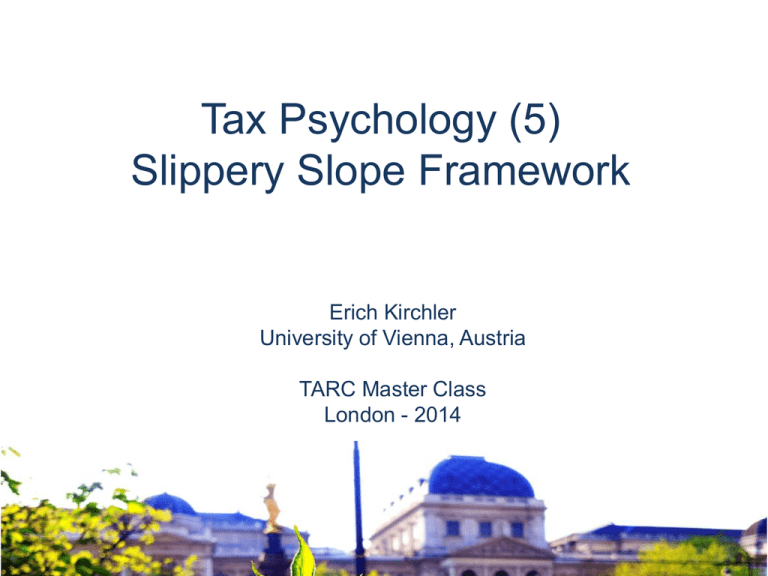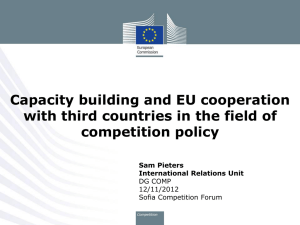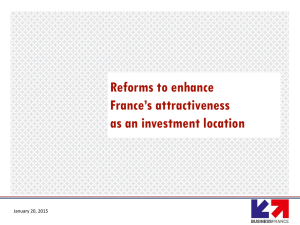
Tax Psychology (5)
Slippery Slope Framework
Erich Kirchler
University of Vienna, Austria
TARC Master Class
London - 2014
Research focus and paradigms
- Type of tax: Income tax (VAT, inheritance tax etc.)
- Actors in the field: The “tax-interaction” context
- Tax behaviour research: Shift of attention from
authoritarian-punitive to cooperate interaction
Decisions under risk
Social dilemma
Differential perspectives
Psychological contract
Interaction climate
Actors in the field: The “tax-interaction” context
Government
Tax authorities
Tax accountants
Taxpayer
Taxpayer
Governance and regulation,
image of taxpayers, tax law, tax
rate
Images of government, tax
accountants and taxpayers, audits
and fines, interaction style
Images of government and tax
authorities, taxpayers and their
goals
Images of government and tax
authorities, attitudes, tax morale,
knowledge of tax law, norms
Taxpayer
(personal,Taxpayer
social, societal), justice
(distributive, procedural,
retributive)
Change of research perspectives
•
Focus on the individual: paying taxes as decision
under risk (Allingham & Sandmo, 1972; Srinivasan,
Fines, audits
1973)
•
Focus on the social group: paying taxes as a social
contribution dilemma (e.g., Dawes, 1980)
Moral, norms,
fairness
•
Focus on differences between taxpayers
Occupation, age,
motivation
(Braithwaite, 2003; 2009)
•
Focus on the relationship between taxpayer and tax
authority: Tax compliance as the result of a
psychological contract (Feld & Frey, 2007; 2010)
•
Focus on the climate: The interaction climate of all
stakeholders shapes tax compliance (Kirchler, 2007;
Kirchler, Hoelzl, & Wahl, 2008)
Intrinsic motivation,
tax authority’s
interaction style
Antagonistic vs
synergistic tax
climate; power,
trust
Social norms
• Wenzel (2005b) refers to social norms as perceived
frequency or acceptance of tax evasion among a
reference group.
• Taxpayers who perceive others as behaving according
to socially accepted rules and who communicate with
others about appropriate behaviour will adopt the
socially shared norms and behave appropriately. If the
reference group signals that non-compliance will be
tolerated, then compliance will decrease.
• If a taxpayer believes that non-compliance is
widespread and a socially accepted behaviour, then
this taxpayer will more likely not comply.
Social norms .....
Wenzel (2004) concludes that taxpayers are influence by other
taxpayers’ behaviour and they are more likely to be influenced
by other taxpayers who are considered members of one’s
relevant self-category; that is, members of the group with which
a taxpayer identifies.
Social norms elicit concurring behaviour when taxpayers
identify with the group to whom the norms are ascribed.
Taxpayers then internalise the social norms and act
accordingly.
Social norms .....
THE BEHAVIORALIST AS TAX COLLECTOR:
USING NATURAL FIELD EXPERIMENTS TO ENHANCE
TAX COMPLIANCE
Michael Hallsworth
John A. List
Robert D. Metcalfe
Ivo Vlaev
Working Paper 20007
http://www.nber.org/papers/w20007
NATIONAL BUREAU OF ECONOMIC RESEARCH
1050 Massachusetts Avenue
Cambridge, MA 02138
March 2014
Fairness
Wenzel (2003) provides a conceptual framework for justice and
fairness considerations:
•
Distributive justice refers to the exchange of resources, both
benefits and costs
•
Procedural justice refers to the processes of resource
distribution
•
Retributive justice refers to perceived appropriateness of
sanctions in case of norm breaking
Distributive justice
Most studies on fairness focus on distributive justice:
Horizontal justice (distribution of taxes and resources
between taxpayers of comparable income groups)
Vertical justice (distribution of taxes and resources across
income groups)
Exchange justice (fairness of tax payments and
governmental provision of public goods and taxpayers’
participation)
Procedural justice
Procedural justice refers to the processes of resource collection and distribution.
Procedures are regarded as fair if the people involved are treated in a way they think is
appropriate. According to Leventhal (1980), treatments are considered fair if decisions
and processes are perceived as being
consistent,
accurate and
free of errors,
representative and
ethical, and
correctable in case of errors.
In discussing public trust and confidence in institutions, Tyler (2001a) argues that the key
issue that shapes public views is a process-based evaluation of the fairness of
procedures that are used to exercise authority.
Central to this process is the communication of respect for the individual.
What shall be done to improve tax compliance ?
Norms and justice
Establishment and communication of social norms of
correct behavior is necessary; and measures need to be
taken that strengthen the identification of
citizens/residents with the community.
Focus needs to be on justice on the distributive,
procedural, and retributive levels.
Service climate
Taxpayers need to be segmented according to their
needs, so that appropriate services can be offered to
facilitate tax honesty and tailored to meet needs at one
“point of sale.”
Method
Sample
Two representative samples of
• 807 private Dutch taxpayers (50.4% men; age: 50.45,
SD = 16.88)
• 1377 Dutch entrepreneurs (68,3% men; age: 48.67, SD
= 11.22)
Data collection
- administered by a market research agency employed by
the Dutch tax administration
- Online questionnaires, telephone interviews, paperpencil survey
2. Correlation between service
orientation and tax compliance
•
•
Private taxpayers:
Entrepreneurs:
r = .22, p < .001
r = .22, p < .001
4. Mediation analyses:
Private taxpayers
Trust
0.13**
0.74***
Service
(0.22***) 0.12**
Tax compliance
Sobel test: z = 2.57, p < .01
Sobel test for mediation analyses with control variables (socio-demographic,
economic and psychological): z = 2.20, p < .05
4. Mediation analyses:
Entrepreneurs
Trust
0.14**
0.73***
Service
(0.22***) 0.11**
Tax compliance
Sobel test: z = 3.72, p < .001
Sobel test for mediation analyses with control variables (socio-demographic,
economic and psychological): z = 1.80, p < .05
Interaction climate (Integration of economic and
psychological perspectives
View of system:
Authorities
Government
Tax authority
Interaction climate;
segmentation and
responsive regulation
Power &Trust
Individuals and groups
interacting in social
system
Voluntary
cooperation vs
enforced
compliance
Taxpayers
Slippery Slope Framework
Tax climate
Power : Antagonistic
climate
Trust : Synergistic
climate
„Cops and robbers“ orientation
• High social distance
• No respect
• Negative emotions
• Cost-benefit calculation
• Enforced compliance
„Service & client“ orientation
• No social distance
• Mutual respect
• Positive emotions, trust
• Feeling of responsibility
• Voluntary cooperation
Key elements
• Power of authorities: Perceived potential of tax
authorities to detect and to punish evasion
• Trust in authorities: Taxpayers‘ perception of tax
authorities as benevolent and working for the
common good
• Compliance: Degree of cooperation by taxpayers
• Enforced compliance vs voluntary
cooperation
Slippery Slope Framework of Tax Compliance
Kirchler, Hoelzl and Wahl (2008)
Enforced Tax
Compliance
Voluntary Tax
Cooperation
Maximum
Maximum
Compliance
Compliance
Minimum
Minimum
Maximum
Maximum
Power of
Authorities
Trust in
Authorities
Minimum
Minimum
Slippery Slope Framework of Tax Compliance
Kirchler, Hoelzl and Wahl (2008)
Enforced Tax
Compliance
Voluntary Tax
Cooperation
Maximum
Synergistic climate
Maximum
Compliance
Antagonistic
climate:
Command
and control
Audits
Fines
Minimum
Maximum
Power of
Authorities
Minimum
Minimum
Subjective
Compliance
complexity of tax
law
Tax morale and
attitudes
Personal, social
Minimum
and societal norms
Fairness
Maximum
considerations
Trust in
Motivational
Authorities
postures
OECD
From Enhanced Relationships to
Co-operative Compliance
Revenue bodies and their relationships with taxpayers and tax intermediaries
need to be built on the principle of reciprocity in which all parties can seek to
co-operate within a framework that both recognises the statutory obligations
and protections available and can go beyond these to produce better
participation and tangible benefits for each party.
+ disclosure and transparency, with all parties being open to enhanced
level od dialogue and co-operation to allwo collaboration in the identification
and resolution of areas of risk and concern; and
+ mutual co-operation in advancing enquiries and reaching
proportionate resolutins quickly and with finality.
HORIZONTAL MONITORING (e.g., Austria, Slovenia, The Netherlands)
22
Horizontal Monitoring
The Netherlands
•
In 2005, the Dutch Tax and Customs Administration initiated the “horizontal
monitoring” program, first involving 20 of the largest businesses. After positive
feedback of the participating businesses, the program was extended to SME’s as
well.
In the horizontal monitoring approach the Dutch Tax and Customs Administration and
taxpayers enter into a compliance agreement, based on the key values mutual trust,
understanding and transparency. The compliance agreement covers a range of taxes.
•
The standard method of customs checking is characterized by ‘vertical supervision’
and distrust. The Dutch Tax and Customs Administration carries out its activities by
selecting and checking.
The principle of horizontal supervision is based on the notion that the Dutch Tax and
Customs Administration operates on the basis of trust rather than distrust. This is a
not implicit trust but it is trust based on experiences from the past (what is the
reputation of the company at the Dutch Tax and Customs Administration) and the fact
that businesses would take their own responsibility.
Studies: Laboratory experiment and online
experiment
Manipulation
Scenarios
Power
Trust
• Audit probabilities
• Procedural fairness
• Efficiency of audits
• Distributive fairness
• Amount of fines
• Positive social representations
• Budget of tax office
• Transparency
• Competence of tax office • Social norms
Study 1
Laboratory Experiment:
N = 64 females & 56 males
Design: 2 (High power vs. Low power) x 2 (High trust vs. Low trust)
20 Periods tax simulation experiment (program: z-Tree, Fischbacher, 2007)
→ Income: 3500 ECU
→ Tax liability: 1400 ECU
→ Audit probability: 10%
→ Fine: amount evaded
Questionnaire (7-point answering scales):
→ Enforced compliance
→ Voluntary cooperation
Mean contributions.
Study 1: Results
1400
1200
1000
800
600
400
High power
Low power
200
0
High trust
Low trust
Study 1: Results
Enforced compliance
Enforced compliance (Resistance, Braithwaite, 2003)
7
6
5
High power
Low power
4
3
2
1
High trust
Low trust
Voluntary cooperation
Voluntary cooperation (Commitment, Braithwaite, 2003)
7
6
5
4
3
2
1
High power
Low power
High trust
Low trust
Covariates: sex = .54, age = 23.68, income = 1.71
Study 2
Online Experiment:
N = 41 females & 86 males; self employed taxpayers
Design: 2 (High power vs. Low power) x 2 (High trust vs. Low trust)
Questionnaire (7-point answering scales):
→ Compliance (α = .84)
→ Enforced compliance (α = .63; Resistance, Braithwaite, 2003)
→ Voluntary cooperation (α = .93; Commitment, Braithwaite, 2003)
→ Strategic evasion (α = .83)
Compliance
Study 2: Results (Compliance)
7
6
5
4
3
2
1
High power
Low power
High trust
Low trust
Study 2: Results
Enforced compliance
Enforced compliance (Resistance, Braithwaite, 2003)
7
6
5
High power
4
3
2
1
Low power
High trust
Low trust
Voluntary cooperation.
Voluntary cooperation (Commitment, Braithwaite, 2003)
7
6
5
4
3
2
1
High power
Low power
High trust
Low trust
Covariates: sex = 0.32, age = 38.54, income = 2.87
Study 2: Results (strategic evasion)
Strategic evasion
7
6
5
High power
Low power
4
3
2
1
High trust
Low trust
Study 3
Survey in Austria
Representative sample of self employed: N = 491
Questionnaire (7-point answering scales):
→ Trust (α = .89 - .91)
→ Power (α = .70 - .77)
→ Enforced compliance (α = .47 -.61)
→ Voluntary cooperation(α = .50 - .74)
Tax compliance by power of authorities and trust in authorities
Enforced compliance by
power of authorities and
trust in authorities
Voluntary cooperation by
power of authorities and
trust in authorities
Cross-cultural testing of the SSF
(44 countries study)
Experimental testing of the main assumptions of the slippery
slope framework in 44 countries on 5 continents
Africa
Asia
Europe
North
America
Australia
South
America
Egypt
Ghana
Morocco
South Africa
Bhutan
China
Hong Kong
India
Indonesia
Iran
Israel
Japan
Pakistan
Russia
South Korea
Thailand
Turkey
UAE
Austria
Finland
France
Germany
Greece
Hungary
Iceland
Italy
Lithuania
Malta
Norway
Poland
Romania
Slovenia
Spain
Sweden
Switzerland
Canada
Mexico
USA
Australia
Brazil
Colombia
Cross-cultural testing of the SSF
(44 countries study)
Sample
Countries
44
N (economics students)
14,694
N per Country
326
M (SD) Age
21.49 (3.30)
Female percentage
52%
Studies
88%
Scenarios
Manipulation of TRUST (high/low) & POWER (high/low)
…Varosia’s legislation is [not] transparent and the government
offers [no] the opportunity of free counselling on judicial subjects and
tax issues in information centers. Furthermore, Varosia’s public
authorities are [little] very service-oriented and [not] interested in
supporting Varosia’s citizens… [TRUST]
…The chance to be audited for self-employed people is very [low]
high. This is to say that self-employed are [not] audited very often.
Therefore, [not] very many of the committed tax offences can be
detected… [POWER]
Scales / Items
• Manipulation checks: trust & power (3 items)
– “The governmental authorities in Varosia act fair towards their citizens.”
– “The governmental institutions in Varosia are very effective in the
suppression of tax criminality.”
• Intended tax compliance (3 items)
– “How likely would you pay your tax completely honest?”
• Voluntary tax compliance (5 items)
– “When I pay my taxes in Varosia as required by the regulations, I do so
to support the state and other citizens.”
• Enforced tax compliance (5 items)
– “When I pay my taxes in Varosia as required by the regulations, I do so
because a great many tax audits are carried out.”
Results I: Manipulation checks
TRUST:
Mean (SD) Low vs. high trust: 2.82 (1.61) vs. 6.27 (1.77)
F(1, 14661) = 16402.14, p < 0.001, η2 = .53
POWER:
Mean (SD) Low vs. high power: 3.05 (1.74) vs. 6.85 (1.79)
F(1, 14661) = 19070.65, p < 0.001, η2 = .57
INTERACTION TRUST x POWER:
Significant (positive) influence of trust manipulation on
perceived power and vice versa
SAME PATTERN OF RESULTS IN EACH COUNTRY
Results II: Intended tax compliance
9
8
Intended Compliance
7
6
5
Intended Tax Compliance
Voluntary Tax Compliance
4
Enforced Tax Compliance
3
2
1
0
Power Low/ Trust Power High/ Trust Power Low/ Trust Power High/ Trust
Low
Low
High
High
Multivariate ANOVA:
Trust: F(3, 14370) =
576.35, p < 0.001,
η2 = .12
Power: F(3, 14370) =
2374.46, p < 0.001,
η2 = .36
Significant effect of the covariate gender: women are more compliant than men!
Results of analyses of variance
Enforced Compliance
•
29,5% of 98,2% of variance are explained by the experimental condition
•
4,8% of 1,8% of variance are explained by the country
Voluntary Compliance
•
9,3% of 95,5% variance are explained by the experimental condition
•
0,1% of 4,5% variance are explained by the country
•
Intended Compliance
•
17,7% of 95,5% variance are explained by the experimental condition
•
0,3% of 4,5% variance are explained by the country
Trust
•
53,8% of 99,3% variance are explained by the experimental condition
•
5,8% of 0,7% variance are explained by the country
Power
•
54,9% of 99,8% variance are explained by the experimental condition
•
6,8% of 0,2% variance are explained by the country
Power > trust
Trust > power
Bhutan
Egypt *
France
Ghana
India *
Indonisia *
Iran *
Israel
Lithuania
Mexico *
Marocco
Norway
Pakistan *
Romania
Turkey
UAE
(* relevant
difference)
Australia
Austria
Brazil
Canada
China
Colombia
Finland
Germany
Greece
Hong Kong
Hungary
Iceland
Ireland
Italy
Japan
Malta
Poland
Portugal
Russia
Slovenia
South Africa
South Korea
Spain
Sweden
Switzerland
Thailand
UK
USA
Corruption
Corruption Perception Index
Corruption Perception Index
β
Variable
B
SE B
Constant
56.80
1.46
Trust
9.56
2.44
.50***
Power
7.87
2.44
.41**
R2
.75
F
62.21***
Note. N = 44
**p < .01. ***p < .001.
Shadow Economy
Shadow Economy Index
Shadow Economy Index
β
Variable
B
SE B
Constant
22.98
1.12
Trust
-2.51
1.86
-.27
Power
-3.55
1.86
-.38
R2
.39
F
12.95***
Note. N = 44
***p < .001.
Happiness
Veenhoven Happiness
Veenhoven Happiness
β
Variable
B
SE B
Constant
6.69
.11
Trust
.165
.18
.18
Power
.468
.18
.50*
R2
.42
F
14.75***
Note. N = 43
*p < .05. ***p < .001.
Note: SWB is the extend of satisfaction with life as inferred from the World Database of Happiness;
it is displayed on the z-Axis and the manifestations per country are shown in a colored spectrum on
the right side of the figure.
Strategic regulation
“State regulation implies that governments act … in the ‘public interest’ …” (Freiberg, 2010, p. 5).
According to Arie Freiberg “Regulation is essentially about the use of power (Freiberg 2010, p. 84).
Power is defined as the potential and perceived ability of a party to influence another
party’s behavior (e.g., Freiberg, 2010; French & Raven, 1959).
French and Raven (1959) and Raven (1965) developed a concept of bases of social power
which distinguishes between
coercive power,
Coercive power
reward power,
legitimate power,
expert power,
Legitimate power
referent power, and
information power.
Coercive power is related to the potential to punish and reward. It originates from the pressure applied through either punishment or remuneration.
Legitimate power originates from the legitimization of the authorities, expert knowledge, skills, access to information, and identification with the
powerful party. In French and Raven’s (1959) theory it bases on legitimate power, expert power, information power, and referent power. Legitimate
power operates through the accepted right to influence others by means of, for instance, agreed election rules, the norm of reciprocity (Gouldner,
1960), social responsibility, and equity norms (Berkowitz & Daniels, 1963).
Impact of coercive and legitimate power
on intended tax compliance
(Hofmann, Gangl, Kirchler & Stark, 2012)
Design: 2 (low vs high coercive power)
x
2 (low vs high legitimate power)
Experimental online questionnaire:
4 Scenarios: low/high coercive & low/high legitimate power
e.g., tax authorities are lenient/strict toward tax evaders and in-/competent.
Scales (72 items): intended tax compliance, implicit trust, reason-based trust,
antagonistic climate, service climate, enforced compliance, voluntary cooperation.
Convenience sample: 121 taxpayers
Sex: 50.4% females
Age: M = 38.77 years, SD = 12.15, range 20–68
Education: 47.9% university degree, 28.1% qualifications for university entrance
Employment: 61.2% employed, 38.4% self-employed
Results
7
6
Intended tax compliance
5
Service climate
Reason based trust
Voluntary cooperation
4
Enforced compliance
3
Antagonistic climate
2
1
Implicit trust
Power
Low legitimate
Low coercive
Intended compliance:
coercive power (CP)
F(1, 117) = 1.00, p = .32
legitimate power (LP)
F(1, 117) = 23.67, p < .001, η2 = .17
Power
Low legitimate
High coercive
Power
High legitimate
Low coercive
Power
High legitimate
High coercive
Reason-based trust:
CP: F(1, 117) < 0.01, p = .95
LP: F(1, 117) = 86.02, p < .001, η2 = .42
Service climate:
CP: F(1, 117) = 0.45, p = .51
LP: F(1, 117) = 84.93, p < .001, η2 = .42
Voluntary cooperation:
CP: F(1, 117) = 1.14, p = .29
LP: F(1, 117) = 27.47, p < .001, η2 = .19
Implicit trust:
CP: F(1, 117) = 0.37, p = .54
LP: F(1, 117) < 2.02, p = .16
Antagonistic climate:
CP: F(1, 117) = 1.80, p = .18
LP: F(1, 117) = 75.86, p < .001, η2 < .39
Enforced compliance:
CP: F(1, 117) = 26.29, p < .001, η2 = .18
LP: F(1, 117) = 2.51, p = .12
Dynamic aspects and regulation of interaction climate
Hypotheses and first empirical results
Power has both positive and negative effects on trust.
The exertion of power may evoke suspicion and mistrust in
the group the measures are imposed on, which can lead to
a vicious circle: mistrust of one party provokes mistrust of
the other party, which justifies and deepens the mistrust of
the first.
Power can have positive effects on trust. Bachmann (2001)
for instance proposes that de-personalized forms of power
(i.e., the power of a system) such as the law can be
perceived as a necessary precondition for trust.
Perceived direction of (coercive) power and anticipated emotions
Erich Kirchler, Katharina Gangl, Barbara Hartl, Eva Hofmann (2014)
Items for Cluster Analysis:
As the tax authority takes
targeted action against tax
evaders, I am feeling
protected by the authority.
As the tax authority
indiscriminately takes
action against all taxpayers,
I’m feeling chased by the
authority.
2
λ= .007
1
Who pays his/her taxes
honestly, does not have to
fear audits and fines.
Even who pays his/her
taxes honestly, has to fear
indiscriminate audits and
fines.
3
1
Diffuse threat
- non compliance
3
λ= .063
2
Targeted action
- compliance
N = 500 self-employed
61% male
Age: 20-65 yrs
February 2014
Jeffrey Owens (OECD)
Workshop at the Economics University Vienna, December
2013
Problems of making good tax policy:
well-trained staff (train and keep them; salaries)
lack of dialog between commissioners & business
(mistrust behavior)
lack of targeted research to benchmark and impose
performance of tax administrators









